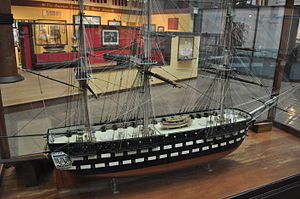USS Vermont (1848)

Model of Vermont as designed at the U.S. Navy Museum
|
|
| History | |
|---|---|
|
|
|
| Name: | USS Vermont |
| Namesake: | Vermont |
| Ordered: | 29 April 1816 |
| Builder: | Boston Navy Yard |
| Laid down: | September 1818 |
| Launched: | 15 September 1848 |
| Commissioned: | 30 January 1862 |
| Struck: | 19 December 1901 |
| Fate: | Sold 17 April 1902 |
| General characteristics | |
| Class and type: | North Carolina-class ship of the line |
| Tons burthen: | 2,633 |
| Length: | 197 ft 1.5 in (60.084 m) |
| Beam: | 53 ft 6 in (16.31 m) |
| Depth of hold: | 21' 6" |
| Propulsion: | sail |
| Complement: | 820 |
| Armament: |
|
USS Vermont (1848) was originally intended to be a ship of the line for the U.S. Navy when laid down in 1818, but was not commissioned until 1862, when she was too outdated to be used as anything but a stores and receiving ship.
Vermont was one of nine 74-gun warships authorized by United States Congress on 29 April 1816. She was laid down at the Boston Navy Yard in September 1818, finished about 1825, and kept on the stocks until finally launched at Boston, Massachusetts on 15 September 1848 in the interest of both space and fire safety considerations. However Vermont was not commissioned at this time. Instead the already aged ship-of-the-line remained in ordinary at Boston until the outbreak of the American Civil War in April 1861.
At this time, the cavernous hull of the vessel was badly needed as a store and receiving ship at Port Royal, South Carolina, and she was commissioned at Boston on 30 January 1862, Comdr. Augustus S. Baldwin in command. She received orders to sail for Port Royal for duty with Rear Admiral Samuel F. Du Pont's South Atlantic Blockading Squadron on 17 February and left Boston on 24 February under tow by the steamer Kensington.
That evening, a violent northwest gale accompanied by snow struck the vessels while off Cape Cod Light, Massachusetts. Kensington let go the tow lines, but Vermont refused to obey her helm, broached, and had all her sails and most of her boats blown and torn away. The gale raged for 50 hours; and, by the morning of the 26th, Vermont was drifting eastward with no rudder, her berth deck flooded, and much of the interior of the vessel destroyed. Later, on the 26th, Vermont sighted the schooner Flying Mist, hailed her, put a man on board and persuaded her captain to return to the east coast and report the helpless condition of the ship to naval authorities. Rescue vessels began to reach the stricken ship on 7 March and enabled Vermont to sail into Port Royal under her own power on 12 April.
...
Wikipedia
